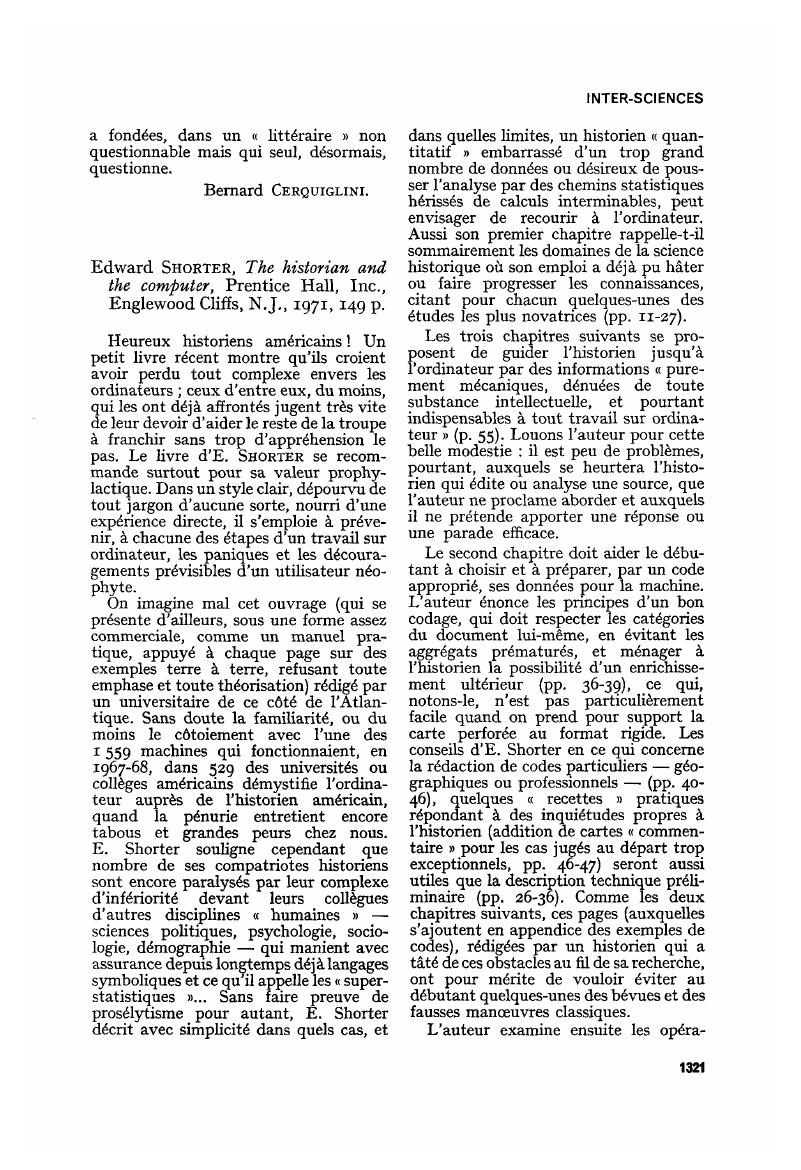No CrossRef data available.
Article contents
Edward Shorter, The historian and the computer, Prentice Hall, Inc., Englewood Cliffs, N.J., 1971, 149 p.
Published online by Cambridge University Press: 25 May 2018
Abstract

- Type
- Inter-sciences
- Information
- Copyright
- Copyright © Les Éditions de l’EHESS 1973
References
page 1322 note 1. Seldvige, J. S. and Rabb, T. K., « DATA-TEXT : a simple and flexible programming System for historians, linguists and other social scientists », Computer studies in the humanities and verbal behavior, I, n° 3, oct. 1968, pp. 107–114.Google Scholar
page 1323 note 1. On lui conseillera néanmoins auparavant quelques autres introductions plus fouillées à l'informatique, comme Green, B. F., Digital computers in research : an introduction for behavioral and social scientists, New York, 1963 Google Scholar ; Janda, Kenneth, Data processings ; applications to political research, Evanston, Ill., 1965 Google Scholar ; Id., Information retrieval : application, to political science, Indianapolis, 1968. Nous avons eu connaissance après la rédaction de ces lignes de l'excellent livre de Dollar, Ch. M. et Jensen, R. J., Historian's guide to statistics. Quantitative analysis and historical research, New York, 1971, Holt, Rinehart & Winston Inc. Google Scholar Ce livre comble enfin, et presqu'entièrement, une lacune bibliographique en présentant à l'usage de l'historien des méthodes statistiques déjà complexes et en abordant de façon plus approfondie, quoique moins aguichante qu'E. Shorter, le thème de l'introduction à l'ordinateur. Nous regretterons seulement que les exemples soient à peu près tous empruntés à l'histoire politique ou électorale ; domaine où les recherches américaines sont particulièrement nombreuses.
page 1323 note 2. En particulier dans les notes des pp. 13 à 26.
page 1323 note 1. Margolis, M., « OSIRIS and SPSS : New computer packages for the analysis of social science data », HMN, II, 2 mars 1970, pp. 15–18 Google Scholar ; Glasco, L. A., « Computerizing the manuscript census », ibid., III, 1, déc. 1969, pp. 1–4, et III, 2, mars 1970, pp. 20-25Google Scholar, suivis du commentaire de Herlihy, D., ibid., IV, 1, déc. 1970, pp. 10–13 Google Scholar, et de la réponse de Glasco, ibid. Plusieurs articles ou notes concernent les bibliothèques de données quantifiées et préparées pour l'ordinateur ; cf. entre autres Clubb, J. M., « The Inter-University Consortium for political research : Progress and prospects », ibid., II, 3, juin 1969, pp. 1–5.Google Scholar
page 1323 note 2. Blumin, S., « The historical study of vertical mobility », HMN, I, 4, sept. 1968, pp. 1–13 Google Scholar ; Formisano, R. P., « Analyzing american voting, 1830-1860 : Methods », ibid., II, 2, mars 1969, pp. 1–11 Google Scholar ; Muller, E. K., « Town populations in the early U.S. censuses : an aid to research », ibid., III, 2, mars 1970, pp. 2–8.Google Scholar
page 1323 note 3. Par exemple, Schreiber, R. E., « Studies in the Court of Wards, 1624-1635. The computer as an aid », CS, I, 1, 1968, pp. 36–42.Google Scholar
page 1324 note 1. Sedelow, W. A., « History as language », C.S., I, 4, déc. 1968, pp. 183–190 Google Scholar ; Cloak, F. T., « The computer in archaeology », ibid., I, 2, août 1968, pp. 61–69 Google Scholar ; J. E. Seldvige and T. K. Rabb, art. cité plus haut. Sur le système converse, Ch. Kellogg, H., « Data management in ordinary english : examples », ibid., I, 4, déc. 1968, pp. 159–182.Google Scholar Plusieurs autres articles rendent bien compte de l'effort de rationalisation et de standardisation que l'ordinateur a introduit dans l'organisation des données et des archives ; par ex., Rhoads, J. B., « The role of the National Archives in facilitating statistical inquiry », ibid., II, 1, janv. 1969, pp. 35–38 Google Scholar, et Allredge, E. C., « Preservation of documentation for conventional and automated Systems », ibid., II, 1, janv. 1969, pp. 40–44.Google Scholar
page 1324 note 2. Bullough, V. L., « The computer and the historian. Some tentative beginnings », C.H., I, 1966-67, pp. 61–64 Google Scholar ; Ch. Dollar, M., « Innovation in historical research : a computer approach », ibid., III, 1968-69, pp. 139–152 Google Scholar ; Murphy, G. S., « Historical investigation and automatic data processing equipment », ibid., III, 1968-69, pp. 1–13 Google Scholar ; Zemsky, R. M., « Numbers and History. The dilemma of measurement », ibid., IV, 1969-70, pp. 31–40.Google Scholar Ici aussi plusieurs articles intéresseront les archéologues, en particulier : Cowgill, G. L., « Computer applications in archaeology », ibid., II, 1967-68, pp. 17–23 Google Scholar et Chenhall, R. G., « The impact of computer on archaeological theory » (avec une bibliographie récente), ibid., III, 1968-69, pp. 15–24 Google Scholar ; « The archaeological data bank. A progress report », ibid., V, janv. 1971, pp. 159-169.




